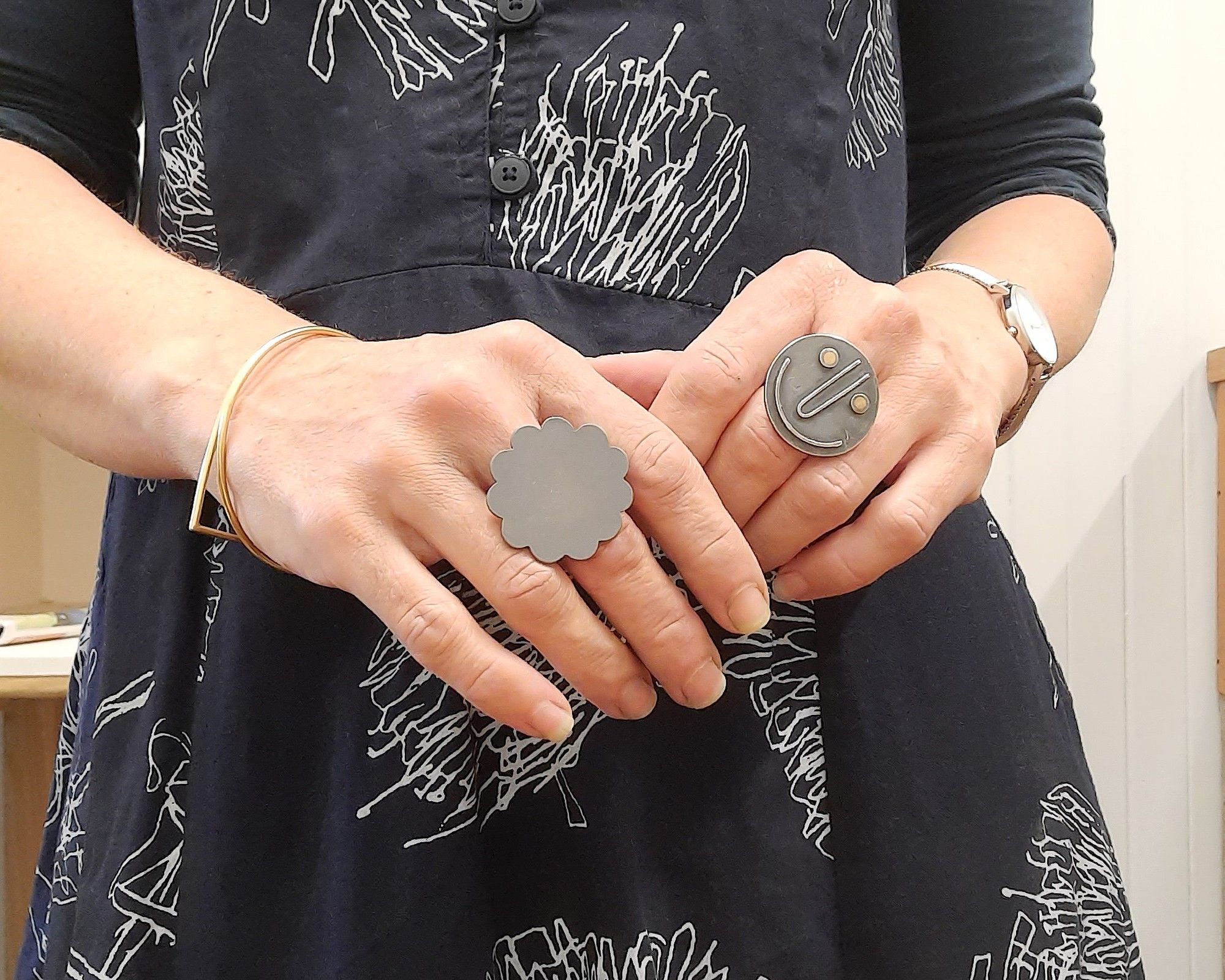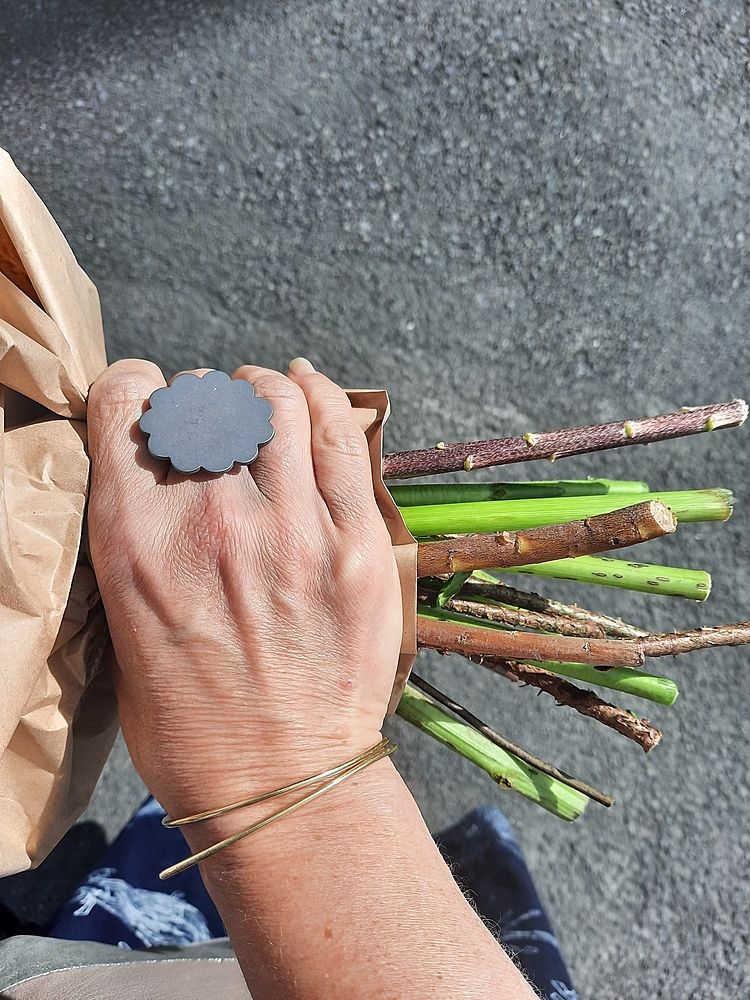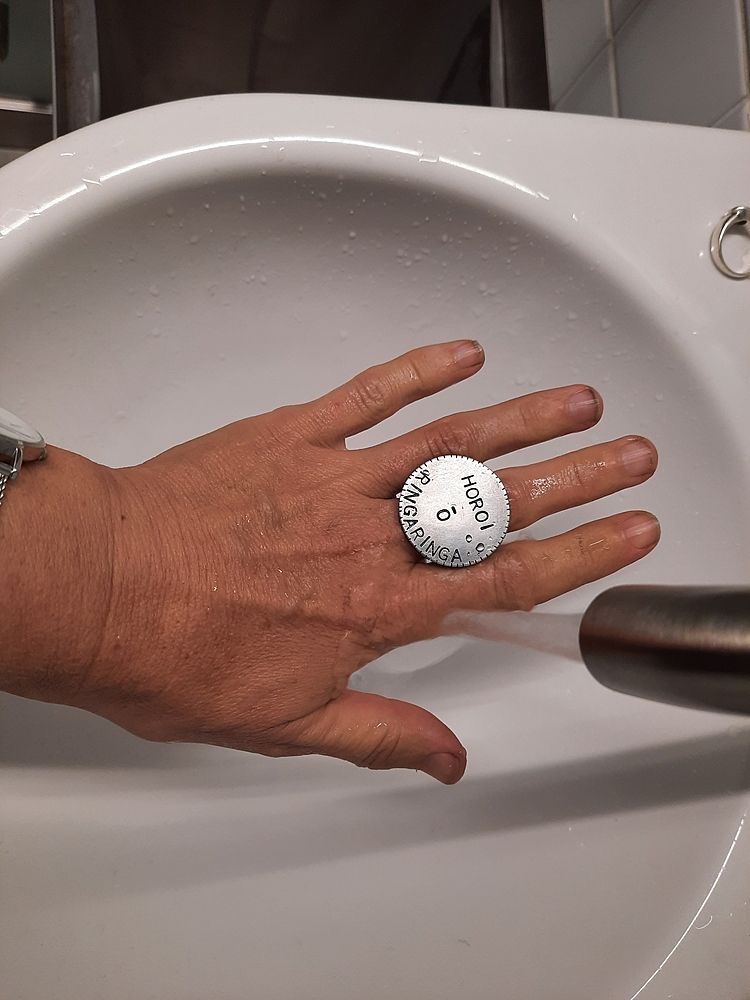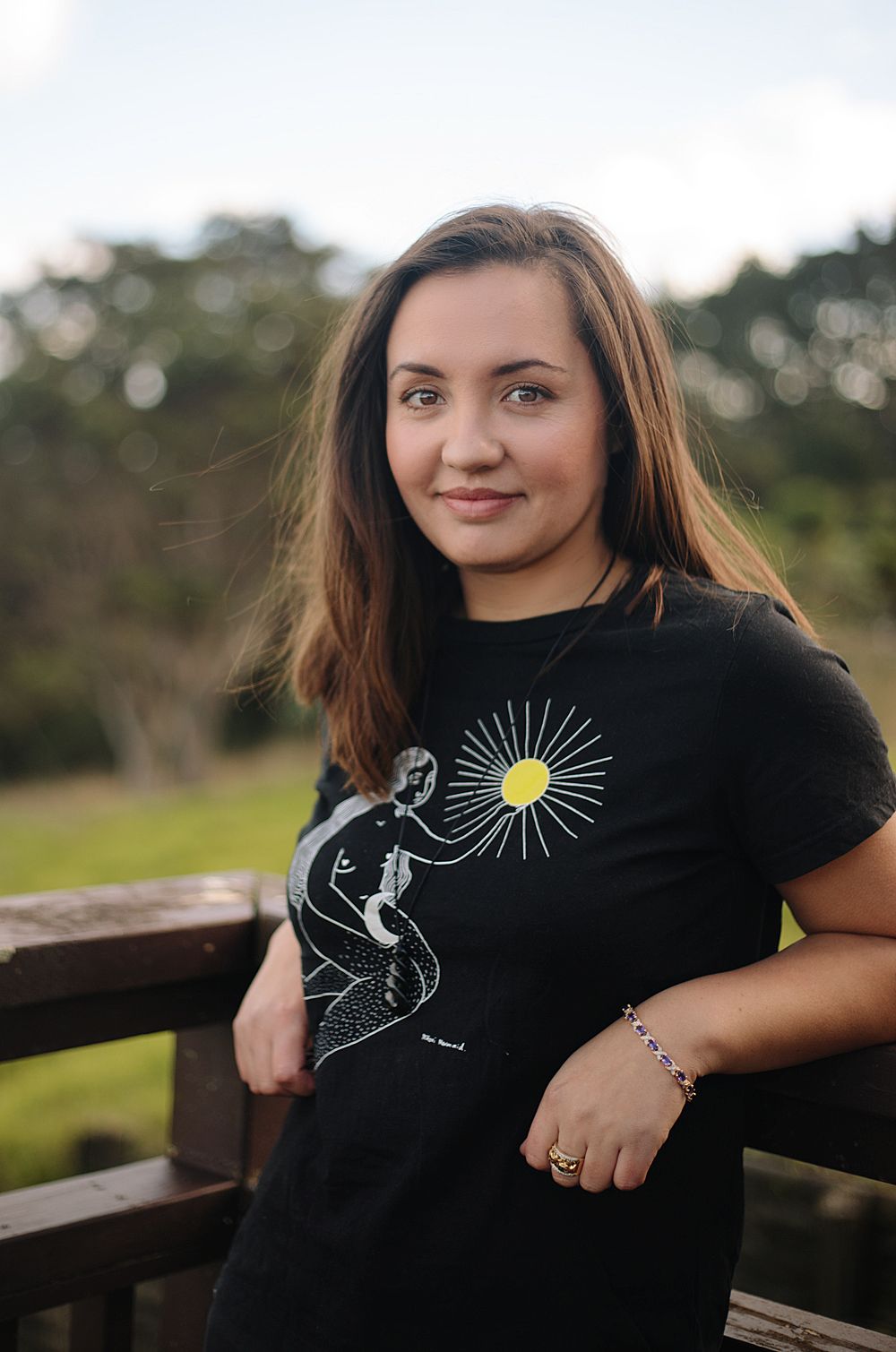Off the Beaten Track with Frances Stachl
Editor Ataria Sharman talks to contemporary jeweller Frances Stachl on jewellery as a holder of narratives, histories and spiritual protection.
In this series, our editors at The Pantograph Punch venture into the regions of Aotearoa to kōrero with some exciting creatives. While wandering the streets of Whanganui, editor Ataria Sharman walked past Frances Stachl’s closed workshop. It stayed with her.
Ataria Sharman: Frances, I came across your gallery recently when I was visiting my sister in Whanganui. On the day that I was passing by, it was closed. How did you start your gallery and, if I could have ventured in, what would I have experienced?
Frances Stachl: I’ve been making jewellery for over two decades. In 2013, I found a flat with a big workshop space downstairs. It was on the Whanganui River, just down from the weekend markets. Because it was so close to the thoroughfare, suddenly I had people peering into my workshop and asking me if they could come in and have a look. This was quite a change for me after 15 years of working in deliberate solitude.
A few years later, I found myself in a position to buy a house on the other side of the river, away from the middle of town. It had a big shed, in case I decided to go back to working from home, but I decided I wanted to see what separating work and home would be like. So in 2019 I moved into the Guyton Street shop. I felt pretty ambivalent about having a retail outlet as I supply several galleries that do a great job of selling my work, but my accountant suggested that I take a six-month lease and give it a go, which I did, and then 2020 happened.
A day or so before Level 4 I locked up the shop and brought my tools home. Unfortunately, I didn’t do a stocktake of metal, and in lockdown I realised I was low on materials. I’d had exhibitions scheduled for 2020, and these were postponed, though they happened later in 2020 when things opened up again. I didn’t make much during the stay-at-home period. Part of me felt like I should be very productive, but I don’t work especially well when I am stressed, and I felt quite anxious.
When I read your question I messaged my big sister in a panic, feeling whakamā
This year I’ve realised I probably need to have regular shop hours, as opposed to opening when I feel like it. I’m generally at the workshop Mondays to Wednesdays with the gallery door shut while I work on things that require concentration. Then I open Thursdays, Fridays and Saturdays to the public. I’m contemplating adding that I am open by appointment, but I’m not sure how disruptive that might be to my work.
The gallery has a front ‘retail space’ with jewellery in cabinets, and my bench and tools in the back half. I think it is a good visual cue to people coming in that the things in the cabinets are made by hand on site. I’m still working out how to sell things – I’m not a natural salesperson and never quite know how to approach people. I often just say hello, and tell people to feel free to pull out drawers and give me a shout if they need help.
AS: One of my iwi on my father’s side is Ngāpuhi, the same as you. My hapū on that side is Ngāti Kura from Matauri Bay, 20 minutes out of Kerikeri. Can you share with me a bit about your own whakapapa connections and how they inform your artistic practice, if at all?
FS: This question has me thinking two things. First, I imagine a line, like a piece of red cord that goes from me back to my mum and from her to her mum (my grandmother) and from my grandmother to her father, and so on. That cord extends beyond me to my sister’s children, and more recently her new mokopuna.
The second thing I feel is profound discomfort. I’ve always known we were Māori, but it wasn’t until I was in my late teens that I knew we were Ngāpuhi. And when I read your question I messaged my big sister in a panic, feeling whakamā because I needed to ask her what our hapū is. She told me it is Ngāi Tawake.
I’m immensely grateful to be part of a culture where there is always space
Of course, my sister has never given me any cause to feel shy about asking, I think it might just be a natural consequence of colonisation. Having to ask who you are can be a bit painful at times. I really admire the certainty some people, including my sisters and Mum, have. While I’ve always been really aware that I am Māori, I’ve also felt really shy about putting myself out there.
Recently, I had a conversation with a fellow jeweller who asked why I wasn’t at a particular hui. I said that I was shy and didn’t want to take up space that someone else could have. He pointed out that there was plenty of room for me. My mum has said similar things, and that it isn’t always about me, it’s about the bigger picture. That sense of collective that many indigenous peoples have. When one of us is successful, we all are. We thrive when we acknowledge that we are part of a bigger whole. I’m immensely grateful to be part of a culture where there is always space.
I’ve been finding myself wanting to make more work that deals with some of the ways I think, as someone who is tangata whenua. I talked to my sister about this and she asked what I imagine will happen with the work. Will it be for sale? Who will own it? Am I comfortable with anyone being able to have it? Sometimes the process of making things is like asking a series of questions. I think I just want to be sure that my questions are careful. This is about my own relationship with being Māori and is something I apply only to my own practice as a maker – I don’t get to tell anyone else how to navigate this.
I believe representation is important, that people can buy things from makers with the appropriate whakapapa and knowledge. Two people who come to mind are Areta Wilkinson and Matthew McIntyre Wilson, who make some of the most beautiful taonga. I have much admiration for these two.
Jewellery only really comes alive when it is worn
.
AS: How did your interest in crafting contemporary jewellery begin? What drew you to this practice?
FS: When I was little my grandmother had what seemed like an amazing jewellery collection. Some pieces were parts of things, and no longer functional. I loved the objects, but mostly I loved the opportunity it gave me to connect with Grandma because each piece came with its own history.
One of the items I remember the most was a pair of small tassels that would have once been on a fob chain. These belonged to my grandfather’s big brother who, I was told, wore a “fedora and smoked like a chimney”. Although he was on Grandpa’s side of the family, I mainly remember Grandma telling the family stories. Those items stuck in my memory because they were immensely tactile, which is something I still aim for.
The other thing that sticks with me is the narrative ability of jewellery. Jewellery can be intensely intimate and meaningful, and the story that goes with an object is as interesting to me as the object itself. I have a family member’s wedding ring, which is a fairly thin, worn band. It is a physically small and quiet object, and whenever I wear it I am powerfully reminded of the intense love in that marriage.
I love the process and tools of jewellery making but, for me, a piece of jewellery only really comes alive when it is worn and develops a relationship with its owner.
AS: Do you see any particular styles or themes emerging from your crafting?
FS: Definitely tactility – is that even a word?
An object needs to feel right in the hand and on the body. I do make lots of necklaces because I like the scope for experimentation the format of the necklace offers. I’m also very fond of repetition as part of the making process and will often make hundreds of little elements to string up as beads.
I like these rings because they are large and, to me, having them on my fingers almost feels like I’m wearing a shield
AS: What do you think is special and unique about the practice of crafting contemporary jewellery?
FS: Jewellery is different from some other fields because of the fact that it goes on the body – this might be an applied art thing. I have handmade cups that I drink out of every day, and that regular usage changes the attachment I might feel because I frequently handle those objects, as opposed to a painting hanging on the wall.
AS: Out of all the pieces you’ve ever made, tell me about your favourite piece of jewellery and why.
FS: This changes frequently – my favourite thing is often the most recent thing I have made.
I’ve been wearing a gold version of the Roimata,or teardrop, bangle I make as part of my production range, the work I remake frequently. Some pieces I only make one to five of, and others I do as a small-scale production.
I also wear one of the Harikoa and one of the Putiputi Pango rings. I like these rings because they are large and, to me, having them on my fingers almost feels like I’m wearing a shield. These rings have a large flat surface and make me think of Wonder Woman repelling bullets with her bracelets. The surface covers the fingers like a shield, and the physical feeling is one of spiritual protection.
.
I made a ring for the local arts review with a similar shield-like feel. On it, I stamped the words ‘Hōroi o Ringaringa’. I wanted to make something that marked Covid-19, but at the same time, I was also thinking about translations and the difficulty of translating from te reo Māori to English, where references to handwashing might be thought about quite differently. In te reo Māori the phrase ‘horoi ō ringaringa’ has different connotations to ‘wash your hands’. Removed from a biblical history it becomes about a shared cleansing ritual performed to keep a community safe.
A week after making this ring, in a New Plymouth bathroom, I removed my rings to wash my hands properly and I realised that someone else had done the same and left a pile of delicate silver rings on the edge of the basin. E hoa, your rings are at the front desk at the Govett Brewster.
AS: What’s on the cards for you for the remainder of the year?
FS: I have a solo show coming up at Avid Gallery in Pōneke later this year, and other than that I’ll just keep making production work – with the occasional foray into something a bit more exploratory.



